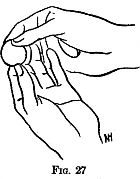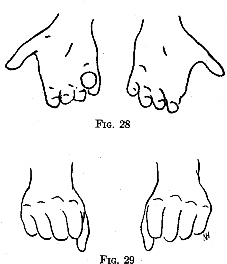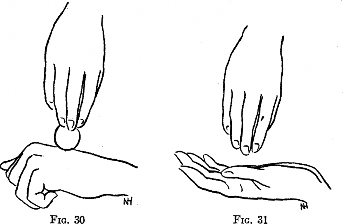
1. THE FLYING COIN
Effect. The invisible flight of a coin from one hand to the other.

1st Method (Robert-Houdin). Have a coin secretly in the right hand, holding it in the regular palm. With the same hand show another coin of the same value and put it between the tips of the thumb and fingers of the left hand. Show this coin and all parts of the left hand, turning slightly toward the left as you do so. Bring the right hand over, the back of the hand to the front, and take the coin in such a way that a great part of it is always visible to the spectators; but at the moment when the two hands come together (Fig. 27) , take advantage of the fact that the palms are hidden to drop the palmed coin from the right hand into the palm of the left hand.
Fix your attention on the coin in the right hand, showing the coin and all parts of the hand; close the left hand, turning its back to the spectators and extending it to the left. Under cover of a pretended throw toward the left hand, palm the coin in the regular palm in the right hand. Finally open the left hand and show that the coin has arrived. The trick bears repetition.

2d Method (M. Trewey). Stand facing the audience, both hands with the palms upwards and about a foot apart, the fingers joined and stretched out to the front, the elbows touching the sides. Show a coin lying on the first and second joints of the right third and fourth fingers (Fig. 28). Announce that the coin will pass invisibly into the left hand.
To do this, rapidly turn the hands over inwards, letting the coin shoot over into the left hand; instantly close both hands, moving them upwards in a circular direction—first outwards and then backwards and downwards to their original position (Fig. 29). If you make the movement of the hands and the secret throw of the coin quickly enough, it will be impossible for the spectators to see the coin as it passes across the small space between the hands at this moment.
Having done the trick, you pretend to begin to do it. Raise your right first above your head, the back of the hand to the front, and pretend to drop the coin into the right sleeve. Move the arm as if aiding it in its descent; wiggle the shoulders; finally shake the left arm, held down at the side of the body, and make a motion of catching the coin as it drops from the sleeve. Then show the coin at the tips of the left thumb and fingers.
The trick can be repeated with a second coin. To do this, retain the coin in the left hand on the lower joints of the third and fourth fingers and place the second coin in the same position in the right hand. When the second throw is made, as before, close the left third and fourth fingers on the coin in that hand and receive the flying coin in the folds of the first and second fingers in such a way that the two coins do not come into contact. Repeat the same pretended journey via the sleeves; but, this time, in the final movement make the two coins clink.
3d Method (L’Homme Masqué). Stand facing the spectators; show the left hand empty, close it, and hold the knuckles upwards—the arm bent and the fist opposite the middle of the body, directed toward the right. Show a coin in the right hand and announce that you are about to pass it invisibly through the back of the hand into the palm.
Hold the coin in the position of the finger hold, the thumb pressing it against the top joints of the two middle fingers and the fingers joined. Strike the back of the left hand with the tips of the right fingers, backs outwards, counting “One.” Lift the hand to repeat the blow and quickly palm the coin in the regular palm, realigning the fingers and thumb instantly; then strike down again, counting “Two.” Repeat the blow and count “Three.” Begin to turn the left hand over, the right fingers still masking it; open the fist slightly, let the coin fall from the right palm into it, and close it again instantly. Immediately afterward turn the right hand over toward the front, keeping the tips of the fingers on the back of the left hand; at the same time complete the turn of the left fist, bringing it palm upwards. On the completion of the turn the right hand is below the left fist and is palm upwards; you point the right forefinger at the left fist, showing the right hand empty, and then slowly open the left hand to prove that the coin has arrived.

The illusion depends on the coordination of the turning of the hands, which should appear to be simultaneous and merely to show the palms of the hands in order to prove that the coin has passed through the back of the left hand.
4th Method (M. Trewey). Make a pretense of slyly taking a coin with your left hand from a pocket on the left side. Close this hand and hold it, back upwards, about waist high. Show a coin in the right hand and hold it between the tips of the thumb and fingers with about half the coin visible. Announce that you will pass it through the back of the left hand. Place the coin perpendicularly on the back of the left hand (Fig. 30) , and push downwards so that the coin passes out of sight behind the fingers. At this point pretend to overhear someone say that you already have a coin in the left hand. Turn that hand over and open it, showing it empty (Fig. 31).
Turn the left hand the reverse way, closing it, and at the precise moment when the tips of the right fingers are hidden by the left hand drop the coin, close the left hand immediately, and again apply the tips of the fingers of the right hand to the back of the left fist. Pretend to press the coin flat, and then rub the fingers on the back of the fist. Finally lift the right hand, turn the left hand over, open it, and show the coin.
Here again the least hurry or the least delay will spoil the illusion. The hands must act in perfect unison. These four solutions of the same problem by these celebrated magicians are worthy of the closest study.
Website Content: © Copyright 2024 by Trickshop.com.